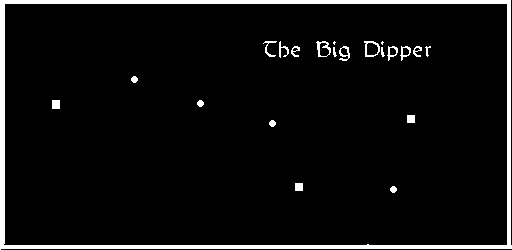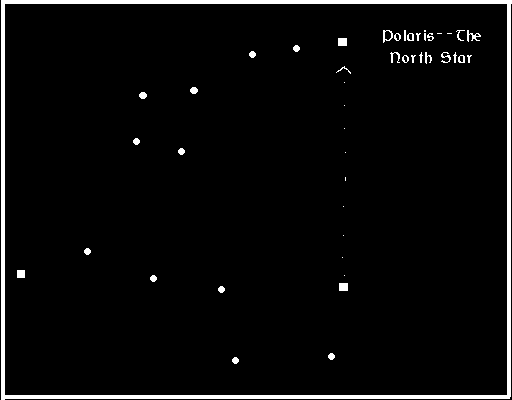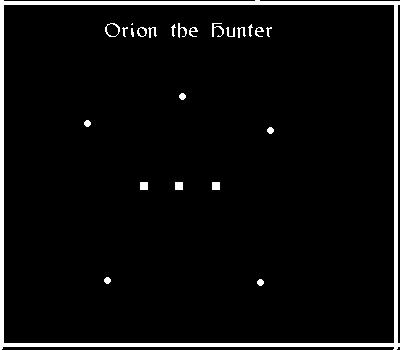If you want to read an interesting book about observing the night sky, look for: The Night Sky Book:An Everyday Guide to Every Night; by Jamie Jobb. I think it is meant to be a little juvenile, but for those of us with simple, childish minds, it's just perfect! Also, encyclopedias are always interesting, too, and you can go to the library and look up tons of books on the subject. Also, if anyone lives in Winnipeg, or gets a chance to go there, there is an awesome planetarium--like an astronomical theatre--stars and planets as they are actually seen in the sky are projected into the inside of a dome--anyways, if you do ever go to Winnipeg, it's located in the Museum of Man and Nature on Main Street, just a little ways north of Portage and Main. I thank the planetarium for giving me the inspiration for this page, and the first article especially.
To see NASA's astronomy pic of the day: click here :)
In ancient times, people were acquainted with the night sky. They used it to tell the time; not just the hours of the day, but days and months and years... They knew how to make calendar systems from what they saw in the sky. They studied the constellations, which usually had special significance to them. They would plan events, such as festivals, and the planting of crops around the motion of celestial bodies. Many people even believed they could predict the future by these motions. The knowledge of generations has been passed down to us, and still we continue to gaze up at the stars, and try to reach through time and space to something we can't even fathom.
Our first topic will be a simple one: Familiarizing Ourselves (very basically) with the Night Sky. Now, we all know that it changes, we do not always see stars, planets, etc in the same position night to night, or season to season. (If you have not noticed this, you might want to look up once in a while). Also, those of you in the other hemisphere see a completely different sky than I do. So, for the purpose of this first....discussion, I guess we'll call it, though I'm the only one saying anything, we will just talk about some of the constellations, etc that I am familiar with, and that are the usual thing that most self-respecting Winnipeggers like to know so we can feel that we know a lot.
We will begin with Polaris, the North Star. This is the star that has been used as a guide to sailors, campers, etc, etc, when they wish to know where they are or where they should be going. The reason for this is that it is always in pretty much the same spot, and it is the star over the North Pole. To find the North Star, you must first find the Big Dipper (part of the Big Bear), an easily seen constellation. It has 7 stars, and looks roughly like this:

Do you see the dipper? Good. Now you look at the last 2 stars in the bowl of the dipper, and go away from the mouth of the dipper in a straight line, about 5x the distance between the 2 star, and you should see Polaris. If you draw an imaginary line in the sky from Polaris straight down to the horizon, that's North.
And that brings us to the next constellation, the Little Dipper. It is a lot harder to spot than it's big brother, especially if you live in a city like I do. (Oh, by the way, a good trick for lessening the damping effects of streetlights on your stargazing is to simply put your hands in front of the street lights, and look at the sky above them. It doesn't totally eliminate it, but it does make a big difference. I learned this little piece of common sense from a gentleman from the planetarium above mentioned, who helped me with a research project on the moon.) So, the Little Dipper.... It looks pretty much the same as the Big Dipper, but it's smaller and faces towards the Big D. when you see them both in the sky it looks like the Little D is pouring into the Big D. Also, the last star in the handle of Little D is.....drumroll, please.....Polaris!! Here is a diagram:

Okay - only one more constellation for today - one of my favourites because it's one of the few I can spot easily! Orion, the Hunter is associated in myths with other surrounding constellations: a bull, two dogs, a rabbit and a unicorn. A book I have says it is seen in the winter. I've never noticed what time of year it's visible, but I have always seen it in the south sky.

I once bought some glow in the dark stars and put up the southern hemisphere on one half of my ceiling. I never got around to doing the Northern Hemisphere - I was getting too discouraged by falling stars. Now I've moved out and not put up my glow-in-the-dark indoor sky again. Maybe someday - I'll put it on my ever-growing to-do list. (you know what that means).
An interesting fact I learned about the moon through doing that project I spoke of: When you watch the moon at night, it appears to move very quickly across the south sky from east to west. however, that 'motion' is because of the Earth's rotation. If you plot the position of the moon each night for a while, you will notice that the moon is actually moving the other way! (And by the way, I don't know about a man in the moon, but there definitely is a girl in the moon, and that girl is me!)
Bibliography: The Night Sky Book by Jamie Jobb, mentioned above. And the other book I mentioned, but I can't remember the name of it.
Well, that's all for now!!
